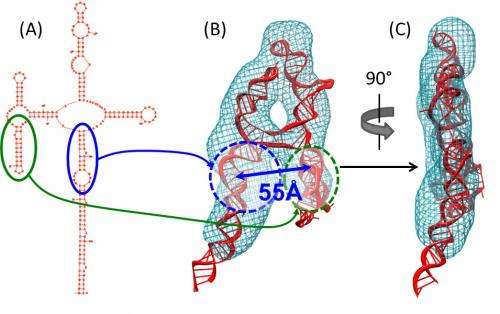New insight on HIV life cycle gained through creative use of high-energy X-rays

(Phys.org) —A key step in the decades-long mystery of the HIV life cycle was uncovered using what formerly was thought of as only a supplementary X-ray technique for structural biology. This advances study of HIV as well as highlights a powerful tool to obtain currently unobtainable high-resolution structural determination and characterization of RNA molecules.
Scientists discovered how the HIV virus recognizes its own messenger RNA amidst the more abundant collection of host cell RNA in order to pass on and replicate the genetic code for the virus. The structural basis for this export has been a mystery for more than 25 years. The use of small-angle X-ray scattering (SAXS) technique, a solution-based method that does not require protein crystallization and has minimal size limitations, succeed where traditional X-ray techniques have failed.
Recently, a team of researchers from multiple institutes solved the structure of the Rev-protein response element (RRE) in HIV-1 RNA genome domain, using SAXS. The team was lead by Yun-Xing Wang, a senior principle investigator at the National Cancer Institute (NCI) at Frederick of NIH, and included Argonne National Laboratory scientists Xiaobing Zuo, Soenke Seifert and Randall Winans, of the X-ray Science Division.
RRE is crucial for the HIV virus life cycle because RRE helps some RNA genome escape the host nucleus intact so that they can be packaged into new viral particles, spreading the virus. This RNA genome translocation from nucleus to cytoplasm is enabled, in part, through forming a complex between RRE domain and Rev-proteins. The structural basis of the recognition between RRE and Rev-protein remained elusive for many years because of the difficulties in the structural determination for the RRE RNA. Crystallography and nuclear magnetic resonance spectroscopy (NMR) are often the major high-resolution structural tools. However, this RRE RNA domain has not been successfully crystallized and it has ~230 nucleotides, which is too large for NMR characterization.
The SAXS experiments were performed at the U.S. Department of Energy's Argonne's Advanced Photon Source at beamlines 12ID-B and 12ID-C.
A molecular envelope derived from the SAXS data showed that the RRE forms in a letter "A" shape with legs about 55 Å apart. This separation coincides with the distance between the binding sites of Rev protein dimer, which reveals that the RNA legs serve as a nucleation site for Rev protein binding and oligomerization along the RNA. Since duplexes are the major building blocks for this RNA, an atomic model is also generated based on the SAXS molecular envelope. Mutagenesis experiments showed that larger separation between the RNA legs by inserting more nucleotides drops the RNA exporting activity dramatically, which confirmed the SAXS structure and the proposed mechanism. As bioSAXS has often been used as a supplemental technique in structural biology, this study can be considered as an important step forward not only in HIV biology, but also in bioSAXS methodology for RNA structural biology. Those results were published in the paper "An Unusual Topological Structure of HIV-1 Rev Response Element" in the journal Cell, in volume 155 issue 3.
More information: "An Unusual Topological Structure of the HIV-1 Rev Response Element." Xianyang Fang, et al. Cell Volume 155, Issue 3, p594–605, 24 October 2013, DOI: dx.doi.org/10.1016/j.cell.2013.10.008
Journal information: Cell
Provided by Argonne National Laboratory


















